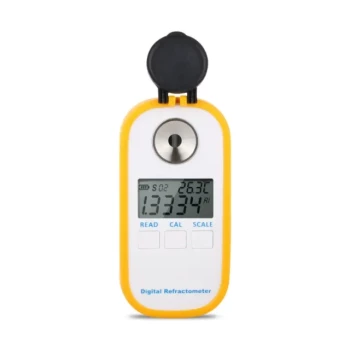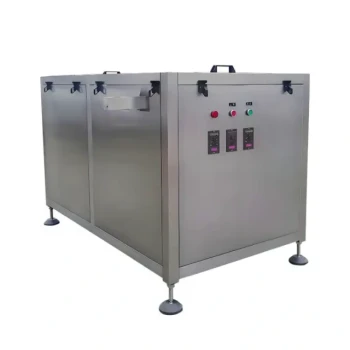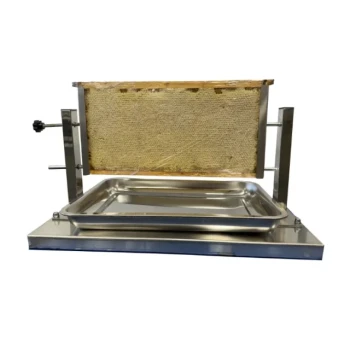To properly maintain a honey refractometer, you must implement a strict three-part process. This involves calibrating the instrument before use, ensuring your honey sample is pure and at the same temperature as the device, and meticulously cleaning the prism with a soft, damp cloth immediately after every single reading.
The accuracy of a honey refractometer depends less on the device itself and more on the discipline of your process. Consistent results come from treating calibration, sample preparation, and cleaning as equally critical steps in a single workflow.
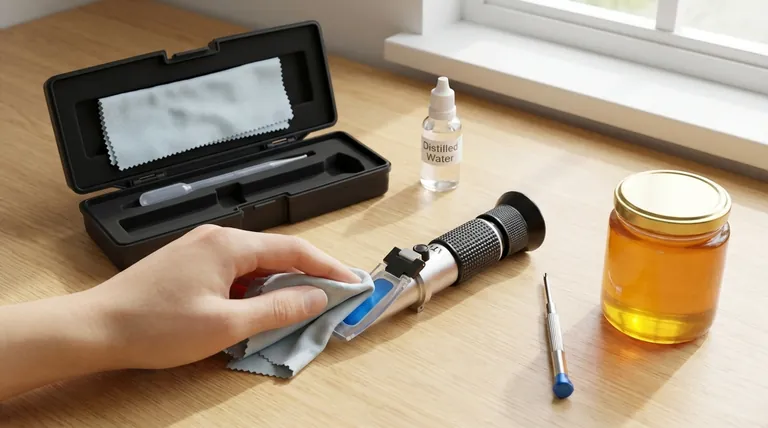
The Foundation of Accuracy: Calibration and Temperature
Before you can trust any measurement, you must establish a correct baseline. This is the entire purpose of calibration and temperature management.
Why Calibration is Non-Negotiable
Calibration sets the "zero point" for your instrument. Without this step, every subsequent reading will be skewed, making your data unreliable for determining honey's moisture content.
Achieving Temperature Equilibrium
The refractive index of honey is sensitive to temperature. For an accurate reading, both the honey sample and the refractometer's prism must be at the same ambient temperature. A temperature difference is a hidden source of significant error.
The Critical Link: The Honey Sample
The quality and application of your honey sample directly impact the light passing through the prism, which is how the device generates a reading.
Ensure Sample Purity
Your honey sample must be completely free from debris like wax, propolis, or other impurities. These particles obstruct the light path and will lead to false readings.
Apply a Thin, Even Layer
You only need a small amount of honey to cover the prism. Apply a thin, even layer to ensure a clear measurement.
Remove All Air Bubbles
After applying the sample and closing the plate, gently wiggle it to remove any trapped air bubbles. Bubbles create empty spaces that interfere with light refraction and invalidate the reading.
The Post-Measurement Protocol: Cleaning and Storage
What you do after the measurement is just as important as what you do before. Proper cleaning and storage are essential for the long-term accuracy and lifespan of the instrument.
Clean Immediately After Every Use
Do not let honey dry on the prism. Dried honey residue can crystallize, creating a film that interferes with future measurements or even permanently damages the prism surface.
Use the Correct Cleaning Materials
Use a clean, soft, oil-free cloth dampened with cold water to gently wipe the prism and faceplate. Immediately dry the surface with a separate, dry tissue to prevent water spots.
Store for Stability and Protection
Store your refractometer in a cool, dry place, ideally within its original protective case. Avoid leaving it near heat sources or in direct sunlight, which can damage the delicate optical components.
Common Pitfalls That Invalidate Readings
Even with the best intentions, small mistakes can compromise your results. Being aware of these common pitfalls is key to maintaining accuracy.
Skipping Post-Use Cleaning
This is the most common and damaging mistake. Even a thin, invisible film of dried honey from a previous reading will alter the next one.
Using Abrasive or Contaminated Cloths
Never use a paper towel or a cloth with oils or dirt on it. These can leave behind a film or, worse, create micro-scratches on the prism, permanently degrading the instrument's accuracy.
Ignoring Temperature Differences
Testing cold honey on a room-temperature refractometer (or vice-versa) is a frequent source of error. Always allow both to acclimate to the same ambient temperature before testing.
A Simple Checklist for Reliable Results
Your approach should be tailored to your specific goal, but the principles of disciplined maintenance remain the same.
- If your primary focus is routine quality control: Establish a consistent, repeatable workflow for calibration, testing, and cleaning for every single measurement.
- If your primary focus is troubleshooting a potential issue: Be extra meticulous with calibration and ensuring complete temperature equilibrium before taking a critical reading.
- If your primary focus is long-term equipment care: Make immediate post-use cleaning and proper case storage your most ingrained habits.
A well-maintained refractometer is an instrument you can trust to protect the quality of your honey.
Summary Table:
| Maintenance Step | Key Action | Why It's Critical |
|---|---|---|
| Calibration | Set baseline with distilled water before each use. | Establishes the instrument's zero point for accuracy. |
| Sample Preparation | Ensure pure honey at the same temperature as the device. | Temperature differences and impurities cause significant errors. |
| Cleaning | Wipe prism gently with a soft, damp cloth immediately after use. | Prevents dried honey residue from permanently damaging the prism. |
Protect Your Honey's Quality with Reliable Equipment
Accurate moisture readings are critical for producing high-quality honey and ensuring its shelf stability. A poorly maintained refractometer puts your entire harvest at risk.
HONESTBEE supplies commercial apiaries and beekeeping equipment distributors with the durable, precision tools needed for reliable quality control. We understand the demands of high-volume operations and provide wholesale-focused solutions you can trust.
Let us equip your business for success. Contact our team today to discuss your needs for refractometers and other essential beekeeping supplies.
Visual Guide
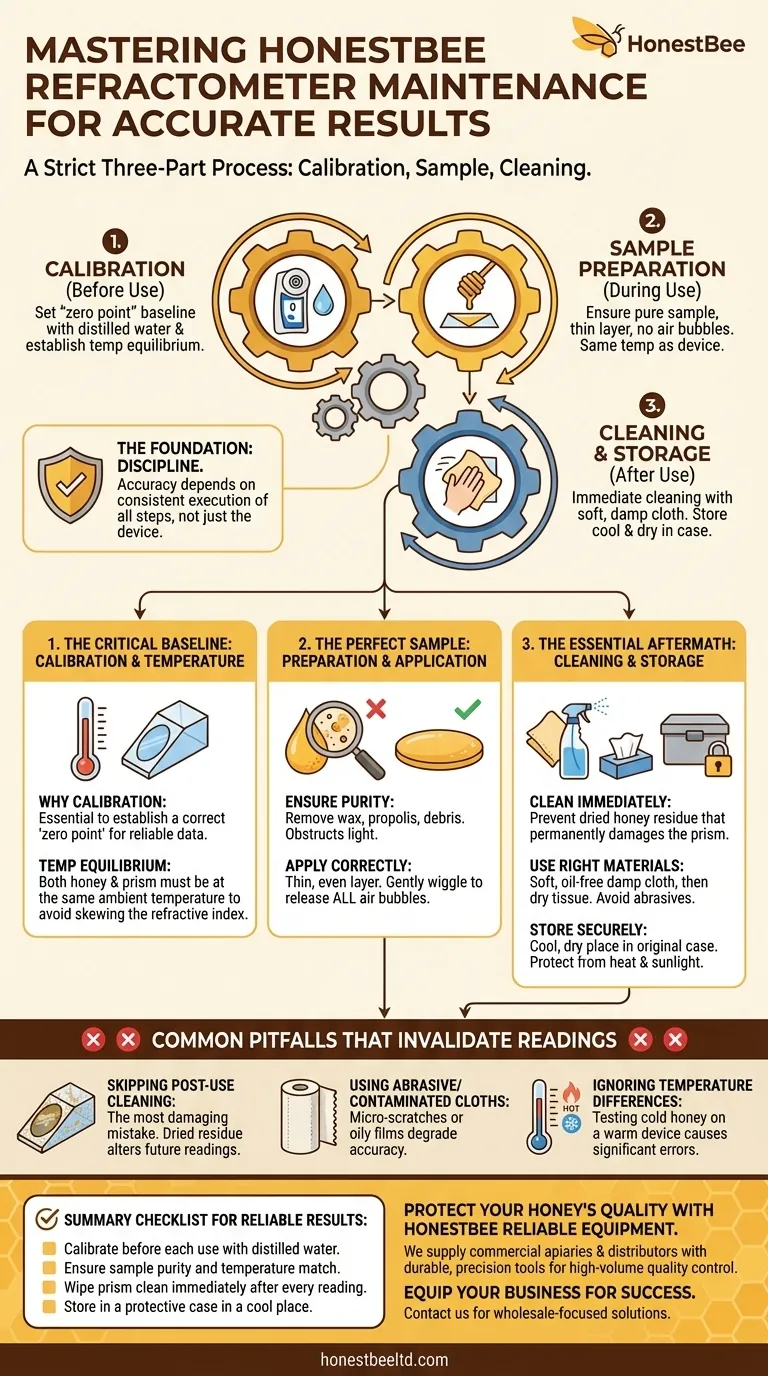
Related Products
- Precision Honey Refractometer Instrument for Quality Assessment
- Digital Honey Refractometer for Precision Measurement of Optimal Honey Quality
- HONESTBEE 3-Frame Manual Acrylic Honey Extractor
- 8-Frame Electric Self-Reversing Honey Extractor Spinner for Commercial Honey Extraction Equipment
- Professional Thermostatic Conical Honey Melter
People Also Ask
- What are the benefits of using a Pocket Digital Honey Refractometer? Achieve Precision & Speed in Honey Quality Control
- How does a honey refractometer work? Ensure Honey Quality & Harvest Readiness
- Why is a honey refractometer considered essential for commercial beekeepers? Ensure Honey Quality and Profitability
- What is a honey refractometer? The Essential Tool for Perfect Honey Quality
- What are the key steps to using a honey refractometer? Ensure Honey Quality & Prevent Fermentation

